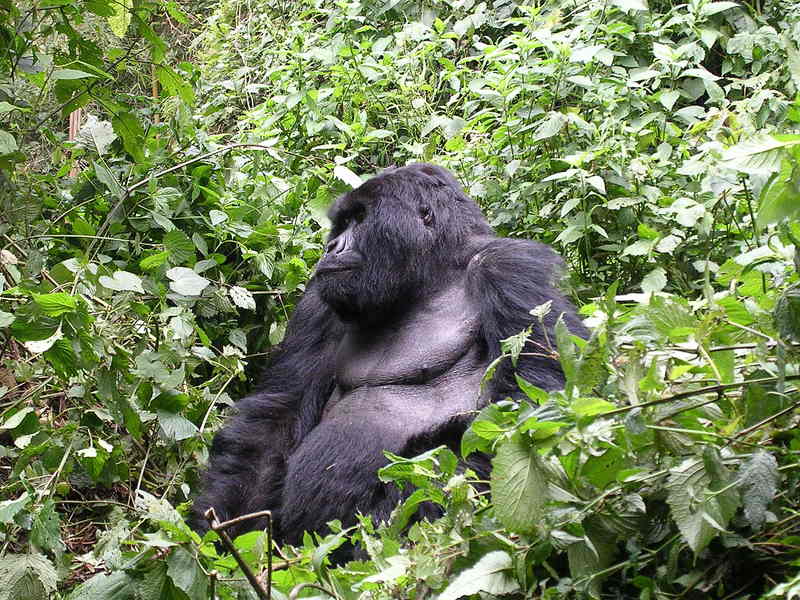|
| Query: gorilla | Result: 11th of 420 | |
Eastern Gorilla (Gorilla beringei) - Wiki
| Subject: | Eastern Gorilla (Gorilla beringei) - Wiki
| |

| Resolution: 2048x1536
File Size: 722369 Bytes
Date: 0000:00:00 00:00:00
Camera: E3100 (NIKON)
F number: f/2.8
Exposure: 10/1245 sec
Focal Length: 159/10
Upload Date: 2006:12:09 11:40:32
|
Eastern Gorilla
From Wikipedia, the free encyclopedia
[Photo] Eastern Gorilla (Gorilla beringei). Date 2003-09-20 12:05:27. Photo by Hendrik Dacquin from Gent, Belgium
The Eastern Gorilla (Gorilla beringei) is a species of the genus Gorilla and the largest living primate. The species is subdivided into two or three subspecies. The Eastern Lowland Gorilla (G. b. graueri) is the most populous, at about 16,000 individuals.[3] The Mountain Gorilla (G. b. beringei) has only about 700 individuals. Scientists are considering elevating the Bwindi gorilla population (which numbers about half of the Mountain Gorilla population) to the rank of subspecies.
Physical characteristics
The Eastern Gorilla is a large homonid with a large head, broad chest, and long arms. It has a flat nose with large nostrils. The face, hands, feet and breast are bald. The fur is mainly black, but adult males have a silvery "saddle" on their back. When the gorilla gets older, the entire fur becomes grayish, much like the gray hair of elderly people. This is why the older males are sometimes called Silverbacks. The Eastern Lowland Gorilla has a shorter, thicker, deep black fur, while the Mountain Gorilla has a more blueish color. Males are much larger than females. A full-grown adult male can weigh up to 220 kg.[4]
Distribution and habitat
The Eastern Gorilla occurs in the lowland and mountain rainforests and subalpine forests of eastern Congo-Kinshasa, southwestern Uganda and Rwanda, within the triangle between the Lualaba River, Lake Edward and Lake Tanganyika. The Eastern Gorilla prefers forests with a substrate of dense plant material.
The species lives in small family groups, containing up to 40 animals. A group is leaded by a dominant male, a silverback, a few related females and their offspring. The Eastern Gorilla is not territorial, and the area of a group gorillas often overlaps with that of other groups.
The gorilla is diurnal and herbivorous; its diet consists mainly of fruit, leaves, and branches. Most of the time is spent by searching for food and resting.
Classification
There are at least two subspecies of the Eastern Gorilla: the Mountain Gorilla (Gorilla beringei beringei) of the volcanic slopes of Rwanda, Uganda and eastern Congo-Kinshasa; and the Eastern Lowland Gorilla (Gorilla beringei graueri) of the lowlands of eastern Congo and Uganda. A small population from the Bwindi Impenetrable Forest in southern Uganda and adjacent areas in Congo differs genetically from the other subspecies, and is therefore often considered as a separate subspecies.
The Eastern Lowland Gorilla and Mountain Gorilla were previously thought to be two of the three subspecies of one single species, the gorilla (Gorilla gorilla). However, genetic research has shown that the two eastern subspecies are far more closely related than the western subspecies: the Western Lowland Gorilla (G. gorilla gorilla), which justified the separate classification. The two eastern subspecies are now classified as G. beringei.
Relation to humans
The Eastern Gorilla is the most critically endangered of the two gorilla species. The hunt for bushmeat and the decline in suitable habitat as a result of intensifying forestry and the development of agriculture form the most important threats for the species. In some national parks, expeditions in search for Mountain Gorillas are a popular tourist attraction. This has both advantages (environmental awareness, financial benefit) and disadvantages (disturbance of natural behavior) for the conservation of the gorillas.
As opposed to the Western Lowland Gorilla, the Eastern Gorilla is seldomly found in zoos. The Antwerp Zoo is probably the only Western zoo that has Eastern Lowland Gorilla's (two older females). The Mountain Gorilla is not held in captivity at all.[5]
References
^ Groves, Colin (16 November 2005). Wilson, D. E., and Reeder, D. M. (eds): Mammal Species of the World, 3rd edition, Johns Hopkins University Press, 181-182. ISBN 0-801-88221-4.
^ Butynski et al (2000). Gorilla beringei. 2006 IUCN Red List of Threatened Species. IUCN 2006. Retrieved on 09 May 2006. Database entry includes a brief justification of why this species is endangered and the criteria used
^ Eastern Lowland Gorilla. World Wide Fund for Nature. Retrieved on 2006-04-18.
^ Caldecott, Julian; Miles, Lera (2005). World Atlas of Great Apes and Their Conservation. University of California Press. ISBN 0520246330.
^ Fossey, Dian (2000). Gorillas in the Mist. Houghton Mifflin Books. ISBN 061808360X.
Retrieved from "http://en.wikipedia.org/wiki/Eastern_Gorilla"
| The text in this page is based on the copyrighted Wikipedia article shown in above URL. It is used under the GNU Free Documentation License. You may redistribute it, verbatim or modified, providing that you comply with the terms of the GFDL. |
|
^o^
Animal Pictures Archive for smart phones
^o^
|
|

